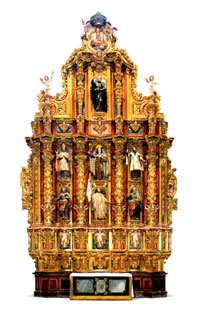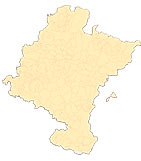pathway Teresian in the rest of Navarre
The only confraternity of the saint in the Kingdom and her altarpiece in the monastery of Fitero
The only confraternity dedicated to the saint in Navarre is that of the espadrille makers of Fitero, constituted in 1696. By that time the monastery already had a canvas of the passage of the transverberation in 1691, the work of Vicente Berdusán, which is among the best of his production and is preserved in the sacristy of the monastery. Undoubtedly, the fact that the saint wore espadrilles must have been the reason for placing the confraternity and guild under the patronage of the saint of Avila. The aforementioned guild grew a lot in the eighteenth century, so that by the end of that century almost three hundred people were supported by the aforementioned craft. In a report of 1799, we read: "the guild of espadrille makers is more thriving. It consumes more than 6 or 7000 arrobas of hemp a year in its manufacture, with which more than 210,000 pairs of espadrilles are made, of which, after supplying the town (which currently uses this footwear) they take the rest to Pamplona, Tudela, Estella and other towns and even to the border towns of France. This guild maintains this guild in the diverse operations of its official document as 260 or 280 people".
The strength of the guild meant that in 1730 a large altarpiece was contracted to José Serrano, the only one of great importance in the Cistercian temple that was paid for by an institution outside the monastery. The same master was in charge of the abundant imagery of the altarpiece, making it according to the contract and in a deliberate program of exaltation of the values of the local church (San Raimundo de Fitero), of the kingdom of Navarra (the co-patrons San Fermín and San Francisco Javier), of Spain (Santa Teresa, patron saint of the brotherhood), adding the sculpture of San Ignacio de Loyola, in memory of the monk from Roncala who administered the goods of the brotherhood, Fray Ignacio de Zubialde. The rich polychromy of gold and the vestments of the saints with bouquets, leaves and flowers executed at the tip of the brush, at one with the rich incarnations generally matte, give the set a unique beauty and, together with its dimensions and location in the magnificent Wayside Cross of the Cistercian temple, makes us one of the great and original altarpieces of the Tudela focus in the eighteenth century.
The feast of the saint was celebrated by the alpargateros on October 15 with all solemnity and procession until the mid-sixties of the last century, as stipulated in the ordinances of the brotherhood of 1696 and the jubilee granted by the Roman Pontiff the following year.
-
ARRESE, J. J., Arte religioso en un pueblo de España, Madrid, CSIC, 1963.
-
GARCÍA GAÍNZA, M. C., "El convento de Carmelitas Descalzas de Lesaca", bulletin del seminar de Arte y Arqueología de Valladolid, 39, 1973, pp. 333-344.
-
FERNÁNDEZ GRACIA, R. and ECHEVERRÍA GOÑI, P. L., "El convento e iglesia de los carmelitas descalzos de Pamplona. Architecture", Príncipe de Viana (1981), pp. 787-818.
-
ECHEVERRÍA GOÑI, P. L. and FERNÁNDEZ GRACIA, R., "El convento e iglesia de los carmelitas descalzos de Pamplona. Exorno artístico", Príncipe de Viana, 164, 1981, pp. 819-891.
-
LABEAGA MENDIOLA, J. C., "Reliquary, autograph and images of Saint Teresa of Jesus in the Parish of Santa María de Viana", Príncipe de Viana, 164, 1981, pp. 893-91.
-
FERNÁNDEZ GRACIA, R. and ECHEVERRÍA GOÑI, P. L., "Fundaciones del Carmen Descalzo en Navarra", Santa Teresa en Navarra. IV Centenary of her death, Pamplona, Grafinasa, 1982, pp. 13-25.
-
ECHEVERRÍA GOÑI, P. L. and FERNÁNDEZ GRACIA, R., "Aportación de los Carmelitas Descalzos a la Historia del Arte Navarro. Tracistas y Arquitectos de la Orden", Santa Teresa en Navarra. IV Centenary of her death, Pamplona, Grafinasa, 1982, pp. 183-230.
-
FERNÁNDEZ GRACIA, R. and ECHEVERRÍA GOÑI, P. L., "Notas para un estudio iconográfico de Santa Teresa en Navarra", Santa Teresa en Navarra. IV Centenary of her death, Pamplona, Grafinasa, 1982, pp. 231-284.
-
ECHEVERRÍA GOÑI, P. and FERNÁNDEZ GRACIA, R., "Vicente and Carlos Berdusán, painters of Santa Teresa. Nuevos lienzos en Pamplona y Lazcano", Santa Teresa en Navarra. IV Centenary of her death, Pamplona, Grafinasa, 1982, pp. 283-298.
-
LABEAGA MENDIOLA, J. C., "Cartas de Santa Teresa de Jesús en Navarra", Santa Teresa en Navarra. IV Centenary of her death, Pamplona, Grafinasa, 1982, pp. 137-182.
-
AZANZA LÓPEZ, J. J., Arquitectura Religiosa Barroca en Navarra, Pamplona, Government of Navarre, 1996.
-
FERNÁNDEZ GRACIA, R., El monasterio de Fitero. Arte y Arquitectura, Panorama Collection, Pamplona, Government of Navarre, Institución Príncipe de Viana, 1997.
-
AZANZA LÓPEZ, J. J., Arquitectura y religiosidad barrocas en Villafranca (Navarra), Pamplona, Grafinasa, 1999.
-
FERNÁNDEZ GRACIA, R., El retablo barroco en Navarra, Pamplona, Government of Navarre, 2003. CARRETERO CALVO, R., "Fundación y construcción del convento de carmelitas descalzos de San José de Tudela /(Navarra), 1597-1603)", Príncipe de Viana (2007), pp. 59-99.
-
FERNÁNDEZ GRACIA, R., "Algunas esculturas napolitanas en Navarra", Pulchrum. Scripta in honorem Mª Concepción García Gainza, Pamplona, Government of Navarre, department de Cultura y Turismo. Institución Príncipe de Viana, 2011, pp. 300-310.












